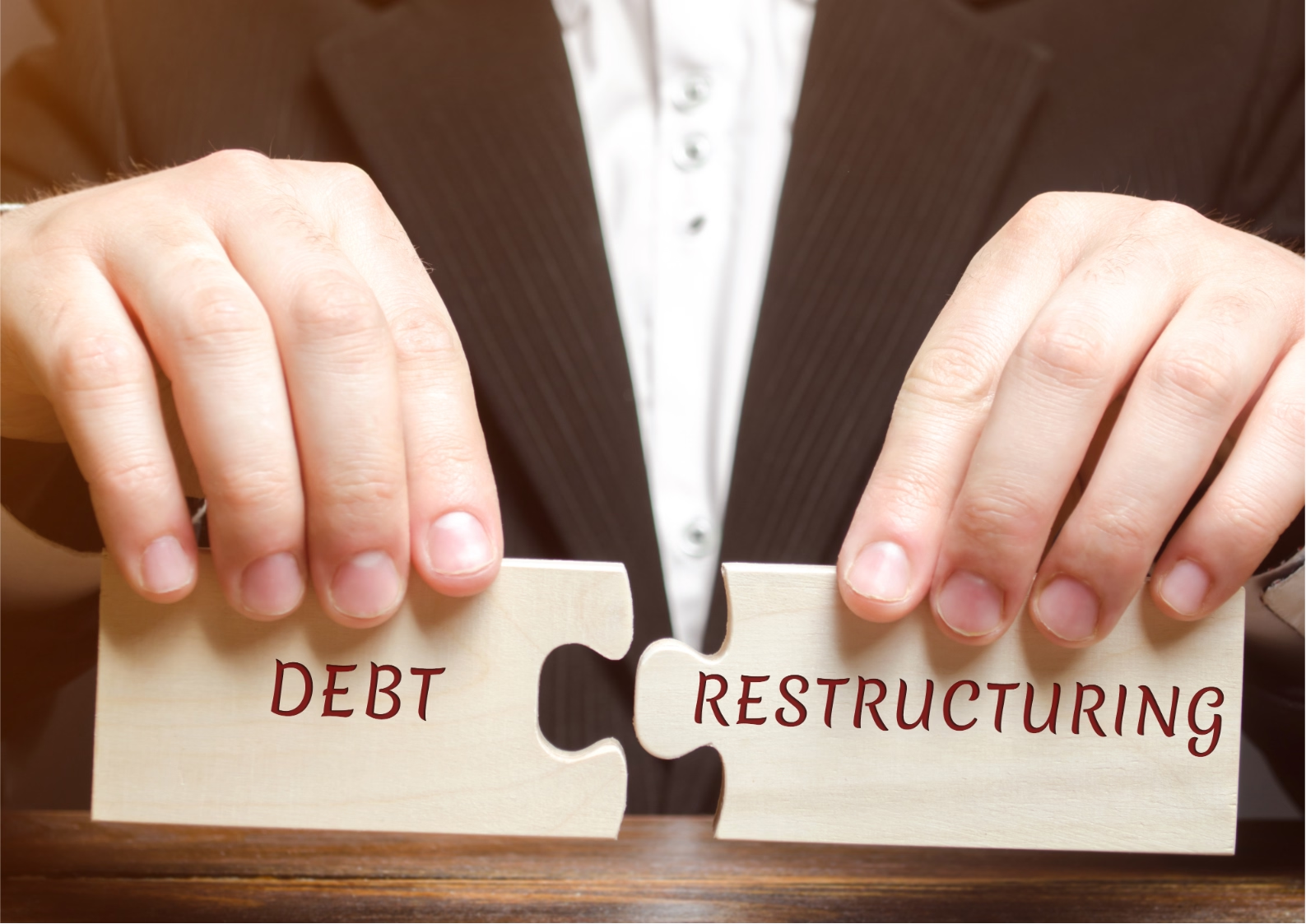
Financial setbacks can happen to even the most well-managed businesses. When debts become unmanageable, business debt restructuring is a valuable tool that can help restore financial stability without resorting to bankruptcy. If you’re looking to reduce financial strain, improve cash flow, and protect your business, understanding your options – including business debt restructuring – is essential.
What Is Business Debt Restructuring?
Business debt restructuring involves renegotiating or modifying the terms of existing debt agreements to make repayment more feasible. It is often carried out by negotiating with existing creditors, and can involve adjusting interest rates, extending payment deadlines, or reducing the principal amount owed. This process is one way that allows businesses to address their debt burdens while staying operational.
For example, a small restaurant business facing declining sales and mounting debt due to construction in the area can attempt to negotiate with creditors to restructure its business debt. Through direct negotiations, the business may secure reduced interest rates on its loans and extend the repayment terms, lowering its monthly obligations.
These adjustments can enable the company to avoid default, reduce financial strain, and focus on stabilizing and growing its operations without the need for new loans or consolidation.
It’s important to keep in mind that depending on your situation, business debt restructuring is not necessarily the best option for you, or even an option at all. For example, if your business is struggling with MCA (Merchant Cash Advance) payments, then a debt relief program may be a better choice.
Why Is Business Debt Restructuring Important for Businesses?
Business debt restructuring offers a lifeline to businesses experiencing financial difficulties. Instead of defaulting or declaring bankruptcy, restructuring can restore liquidity, protect the business’s reputation, and provide breathing room to focus on growth.
This is one way that companies can stabilize cash flow and reallocate resources more effectively.
Common Debt Restructuring Strategies for Businesses
Different business debt restructuring strategies can address unique financial challenges, making it possible for businesses to regain control over their financial health. Not all situations allow for business debt restructuring, which is why it’s important to understand the type of debt you face, and the most desirable option in each situation.
Here are the most common approaches:
1. Negotiating with Creditors
Direct negotiations with creditors can potentially lead to mutually beneficial adjustments in debt terms. Creditors may agree to reduce interest rates, extend payment schedules, or even forgive a portion of the debt. Effective negotiation can protect the business while reassuring creditors of repayment potential. This isn’t always possible however, and can be resource-intensive.
2. Debt for Equity Swaps
In cases where debts are significant, creditors may agree to trade a portion of the business’s debt for equity. This allows creditors to gain a stake in the company while reducing the debt burden on the business. While shareholders may experience dilution, this strategy can help distressed companies avoid bankruptcy.
3. Bondholder Haircuts
When businesses owe a significant amount to bondholders, a “haircut” on bonds can provide relief. This involves reducing the principal or interest owed, allowing the company to make payments that align better with its financial situation. This strategy is often negotiated with bondholders and provides the company with more immediate cash-flow flexibility.
Signs Your Business May Need Debt Restructuring
Not all financial challenges require debt restructuring, but certain warning signs can indicate it may be necessary. If your business is exhibiting one or more of the following, it could be worth exploring your options for managing your debt:
- Consistently low cash flow or recurring negative cash balances
- Difficulty meeting monthly debt obligations
- Creditors contacting the business regarding overdue payments
- Reliance on high-interest credit for basic expenses
- Declining credit scores due to missed payments
When these signs are present, seeking debt restructuring could be a proactive step toward stabilizing the business.
What is the Process of Debt Restructuring?
The debt restructuring process typically involves:
- Financial assessment: Analyzing the business’s financial statements to understand the scale of the debt problem.
- Identifying strategies: Evaluating the best restructuring strategies based on debt type, creditors involved, and business goals.
- Engaging creditors: Initiating discussions with creditors to negotiate new terms.
- Implementing changes: Finalizing agreements with creditors and updating debt terms.
Benefits and Risks of Business Debt Restructuring
While the benefits of business debt restructuring sound alluring, there are some caveats that need to be kept in mind. Here are some benefits and risks:
Benefits:
- The potential of improved cash flow and lower monthly obligations
- Possible reduction in overall debt levels or interest payments
- If successful, the enhanced ability to focus on business growth rather than debt management
- The preservation of business ownership and operations, including avoiding bankruptcy
Risks:
- Not available in all situations, and can heavily depend on the type of debt owing
- Reliant on creditors agreeing, which is not always the case
- Restructuring may extend debt terms, creating long-term commitments
- Potential dilution of equity if creditors exchange debt for equity
- Possibility of strained relationships with creditors if negotiations are unsuccessful
When to Seek Professional Help for Business Debt Restructuring
While some business owners may attempt debt restructuring independently, professional assistance can provide deeper insights and increased chances of success. Consulting a business debt restructuring expert can offer access to negotiation expertise, creditor relationships, and strategic insights, ultimately helping businesses achieve better outcomes than they might alone.
How Coastal Debt Resolve Can Assist With MCA Debt
If you’re struggling with MCA payments, Coastal Debt Resolve are the experts at securely resolving your debts and ensuring business continuity.
While there are some similarities with classic business debt restructuring, the process required to address MCA debts effectively is not necessarily the same as business debt restructuring.
With Coastal Debt Resolve, businesses qualifying for the program can get immediate relief, flexible repayment terms, and robust legal protection. There are three easy steps to get started:
1: Book a free, confidential consultation with a debt settlement specialist
2: If eligible, you can get your immediate cash injection into your business, providing Coastal Debt Resolve with additional time to negotiate an optimal debt solution for you
3: You graduate debt-free in 6 - 18 months, and secure your business's future
Interested in learning more? Check your eligibility here.
Conclusion: Understanding Business Debt Restructuring
Business debt restructuring is a powerful tool for companies facing financial distress. By leveraging effective strategies and when relevant seeking professional assistance, businesses can manage debt, restore cash flow, and focus on long-term success.
Coastal Debt Resolve is here to support businesses struggling with MCA payments every step of the way, offering tailored solutions for sustainable financial recovery.
Disclaimer: The information provided in these materials is for general informational purposes only and is not intended as legal or financial advice. While we strive to ensure that the content is accurate and up-to-date, it should not be relied upon as a substitute for legal advice. Performance information may have changed since the time of publication. Past performance is not indicative of future results.
Frequently asked questions
Yes, but working with a professional often leads to better negotiation outcomes and minimizes risks. Experts bring knowledge and relationships that can simplify and enhance the restructuring process.
No, debt restructuring is designed to preserve your business, not take it away. In cases where debt is exchanged for equity, your ownership share may reduce, but it doesn’t necessarily result in loss of control.
No, debt restructuring is a preemptive approach to manage debt, while bankruptcy is a legal process that liquidates or reorganizes a business's assets to pay creditors.
The timeline varies, typically ranging from weeks to several months, depending on the debt volume, creditor agreements, and the complexity of negotiations.







